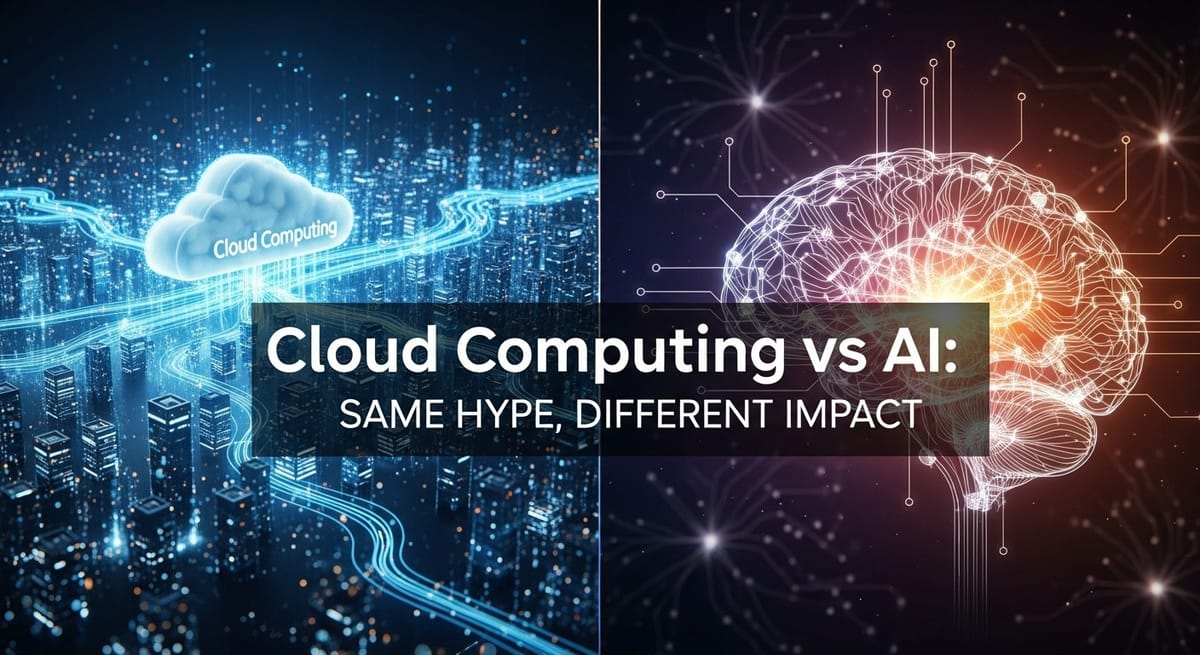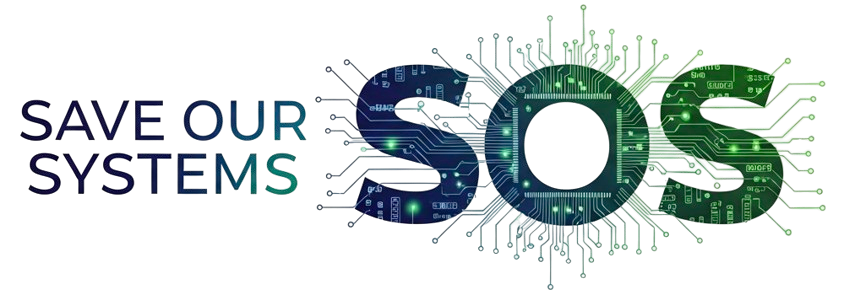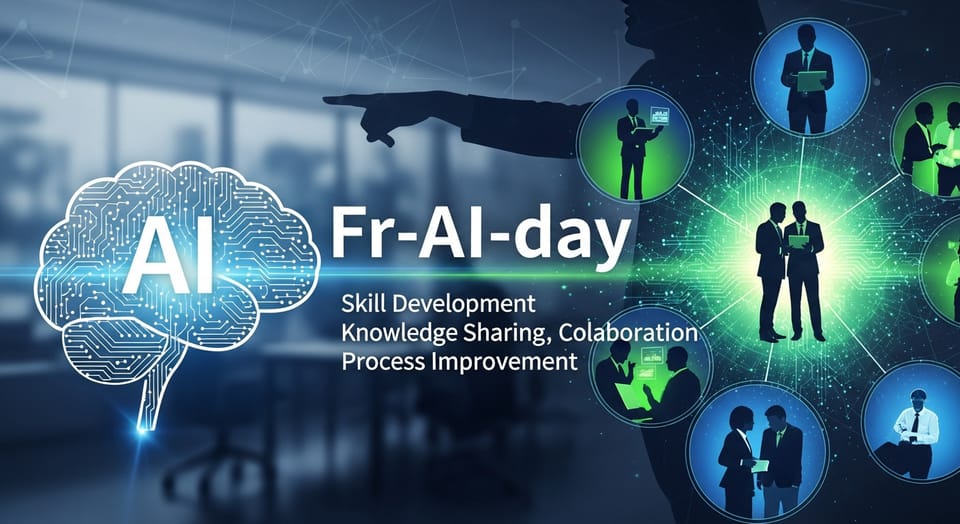Cloud Computing vs AI: Same Hype, Different Impact

When cloud computing emerged as the next big thing in technology, organizations scrambled to adopt it, often without clear ROI frameworks. Fast forward to today, and we're witnessing a similar pattern with artificial intelligence. But while these technology waves share comparable hype cycles and implementation challenges, they differ fundamentally in their organizational impact.
The Organizational Footprint: Departmental vs Enterprise-Wide
Perhaps the most striking difference between cloud computing and AI lies in their scope of influence within organizations. Cloud computing primarily transformed IT departments and technical infrastructure, shifting from on-premises hardware to virtualized, remote infrastructure. This change, while significant, remained largely contained within technical teams, affecting software development processes and IT budgets.
"Cloud computing was revolutionary, but its revolution happened mainly behind the scenes in server rooms and IT departments," notes the McKinsey Global Institute in their 2023 report "Notes from the AI frontier."
In contrast, AI has the potential to impact virtually every position within an organization. From marketing to human resources, customer service to product development, AI tools are being deployed across departmental boundaries. This represents a fundamental difference in how these technologies influence organizational structures and workflows.
Harvard Business Review's research by Davenport & Ronanki confirms this pattern, observing that "AI adoption requires involvement from multiple business units rather than being primarily IT-driven." The cross-functional nature of AI implementation distinguishes it from previous technological shifts like cloud computing.
Same Rushed Adoption, Different Stakes
Both technologies experienced similar patterns of corporate adoption characterized by:
- Rushed implementation without clear ROI frameworks
- Competitive pressure driving adoption ("fear of missing out")
- Significant investment bubbles with inflated valuations
- Over-promising of transformational benefits
Companies often pursued both cloud and AI technologies regardless of whether they made productivity or financial sense for their specific business context. Gartner's "Cloud Strategy Leadership" Research Report identifies strong parallels between cloud adoption a decade ago and current AI implementation approaches, with both characterized by reactive adoption driven by competitive concerns rather than strategic planning.
However, the stakes differ significantly. When cloud implementations failed to deliver on their promises, the consequences were largely limited to wasted IT resources and budget inefficiencies. With AI, the potential downside extends to customer experience, product quality, and even brand reputation as AI becomes customer-facing and integral to business operations.
Technical Implementation: Specialized vs Collaborative
The technical expertise required for cloud computing was largely concentrated within IT departments. While specialized, this knowledge remained contained within established technical roles. The shift primarily involved technical professionals learning new platforms and processes.
AI implementation, however, demands both technical expertise and domain-specific knowledge across different business functions. Effective AI deployment typically requires collaboration between technical teams and domain experts throughout the organization.
MIT Sloan Management Review's "Beyond the AI Hype Cycle" highlights that successful AI implementation demands a hybrid approach combining technical and domain expertise, unlike cloud computing which could be managed primarily by IT specialists. This difference in expertise requirements affects how organizations structure their implementation teams and approach technology integration.
"Cloud computing required technical knowledge to implement, but AI requires both technical knowledge and deep domain expertise to be effective," the report states. "This collaborative requirement represents a fundamental shift in how organizations must approach technology adoption."
Business Model Transformation: Cost Structure vs Operational Paradigm
Cloud computing primarily transformed IT cost structures, shifting from capital expenditures (CapEx) to operational expenditures (OpEx) and providing technical scalability. While significant, these changes were largely invisible to non-technical stakeholders and customers.
The advantages of moving to the cloud were clear and concrete: easier scalability, elimination of large capital expenditures for maintaining private datacenters, and more flexible resource allocation. These benefits, while substantial, primarily affected IT operations and budgeting processes.
AI, by comparison, has the potential to fundamentally transform business models, customer experiences, and operational processes in ways visible throughout the organization and to external stakeholders. It can transform how work is performed across departments, making employees more efficient regardless of function or position.
The World Economic Forum's "The Future of Jobs Report" emphasizes that AI will likely reshape job roles and create entirely new positions that didn't previously exist. This level of transformation goes well beyond the infrastructure changes introduced by cloud computing.
Ethical and Governance Considerations: Technical vs Existential
Cloud computing raised concerns primarily around data security, sovereignty, and privacy. These issues, while important, were largely technical in nature and could be addressed through established security and compliance frameworks.
AI introduces a more complex set of ethical considerations including:
- Algorithmic bias and fairness
- Transparency and explainability
- Job displacement concerns
- Creative rights and intellectual property questions
These considerations extend beyond technical departments and require input from legal, ethical, HR, and executive leadership teams. They touch on fundamental questions about work, creativity, and human agency in ways that previous technological shifts did not.
The governance requirements for AI implementation are correspondingly more complex, requiring organizations to develop new frameworks that address these multifaceted ethical concerns while still enabling innovation.
Learning from History Without Being Bound By It
The parallels between cloud and AI adoption provide valuable lessons for organizations navigating the current technological landscape. The rushed implementation and FOMO-driven adoption patterns of the cloud era serve as cautionary tales about the importance of strategic planning and clear ROI frameworks.
However, organizations must also recognize the unique characteristics of AI that distinguish it from previous technological shifts. The enterprise-wide impact, collaborative expertise requirements, and complex ethical considerations demand new approaches to implementation and governance.
By understanding both the similarities and differences between these technological waves, organizations can develop more effective strategies for AI adoption that capture the transformational potential while avoiding the pitfalls of previous technology bubbles.
As technology continues to evolve, the most successful organizations will be those that can learn from history without being constrained by it, adapting their approaches to match the unique characteristics of each new innovation.
Sources
- Gartner. (2023). "Cloud Strategy Leadership" Research Report. [Identified differences in adoption patterns between cloud and emerging AI technologies]
- Harvard Business Review. (2022). "AI Adoption in the Enterprise" by Davenport & Ronanki. [Discusses the cross-functional impact of AI compared to previous technology waves]
- McKinsey Global Institute. (2023). "Notes from the AI frontier: Applications and value of deep learning" [Details how AI impacts roles across organizational structures]
- MIT Sloan Management Review. (2021). "Beyond the AI Hype Cycle" [Compares technology adoption patterns between cloud and AI implementations]
- World Economic Forum. (2023). "The Future of Jobs Report" [Provides data on how AI affects different organizational roles compared to previous technology shifts]




